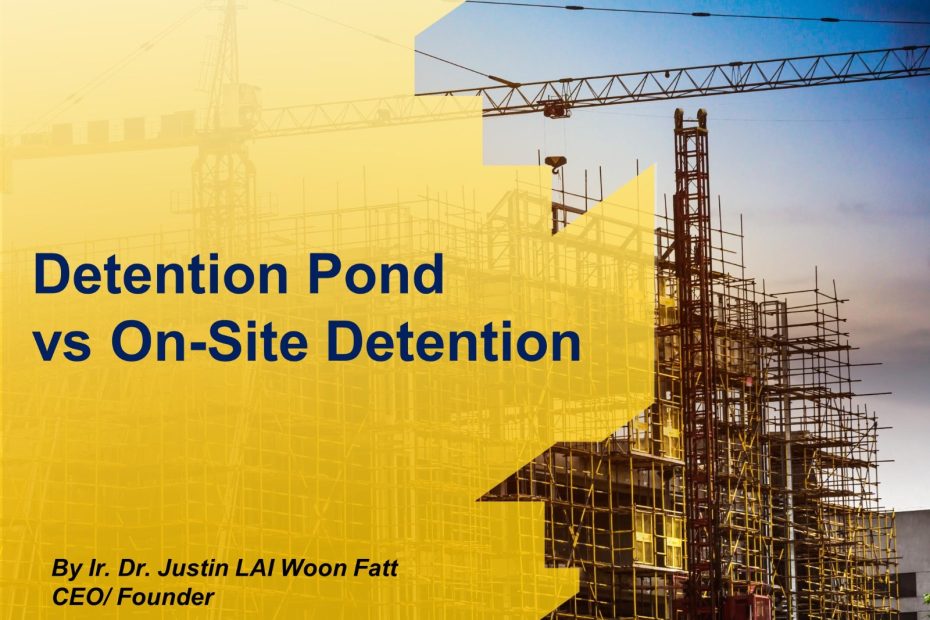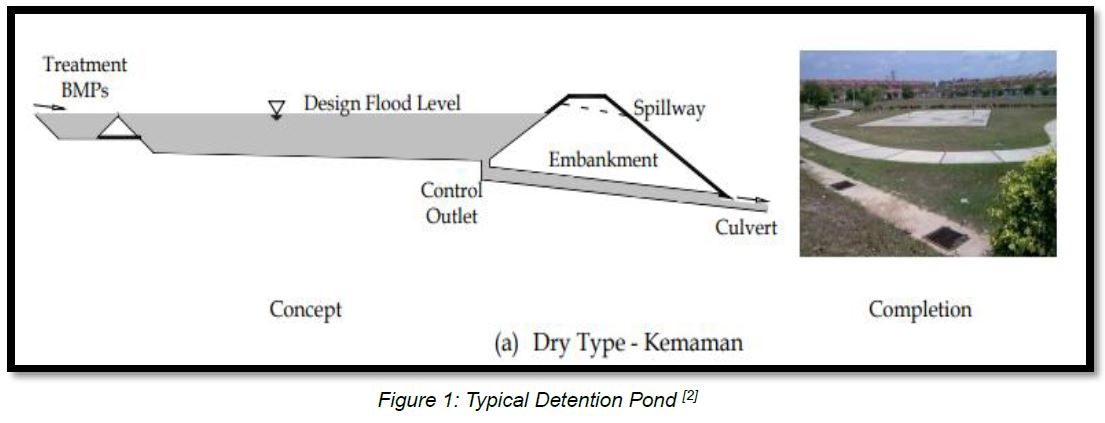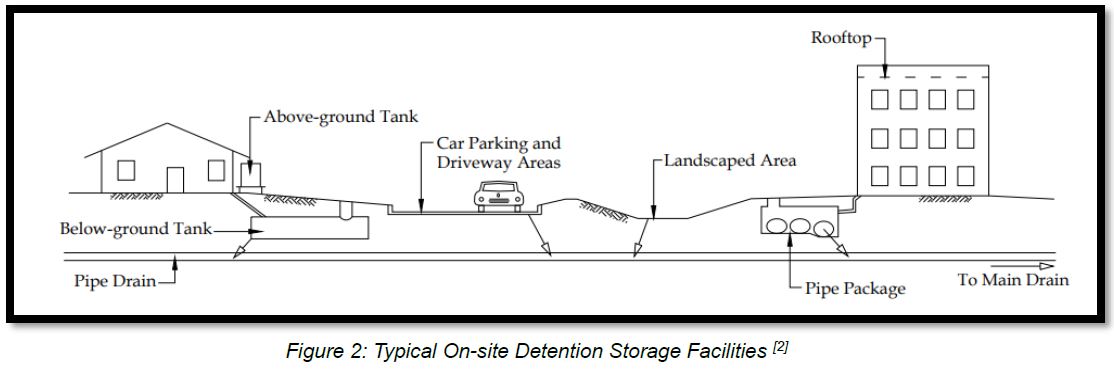Author: Ir. Dr. Justin LAI Woon Fatt | 26 September, 2023
INTRODUCTION
Water diversion becomes more important as communities expand. Stormwater runoff overflows city sewage systems and can erode surrounding streams and rivers, damaging nature [1]. Stormwater management is the practice of managing and minimizing the effects of stormwater runoff to maintain water quality, reduce flooding, and protect the environment. In fact, creating a basin is a common way to manage stormwater. Basins are designed to hold the water and release it appropriately to avoid flooding or eroding the soil.
An important change in stormwater management procedures occurred with the introduction of MSMA (Manual Saliran Mesra Alam) in Malaysia in the year 2000. In order to manage urban stormwater runoff effectively, detention ponds and on-site detention (OSD) systems were also significant MSMA components. OSD systems, supported by MSMA, offer space-efficient solutions, particularly in urban areas, while detention ponds regulate peak flows and lessen the risk of flooding. Since 2000, Malaysia has relied heavily on these stormwater management techniques, which were influenced by MSMA, to reduce flooding and preserve water quality [2].
DETENTION POND
A detention pond, also known as a stormwater detention basin or simply a detention basin, is a man-made water management structure designed to temporarily store and control the flow of stormwater runoff. Detention ponds are an essential component of stormwater management systems, particularly in urban and rural areas, where impervious surfaces like roads, parking lots, and buildings can cause rapid and excessive runoff during rainstorms [3].
Advantages
- Effective Flood Control:
When it rains heavily, the pond gathers the extra water and stores it, keeping downstream communities safe from being overrun. Detention ponds lessen the possibility of localized floods by controlling the rate of outflow. - Groundwater Recharge:
Detention ponds can occasionally be made to promote groundwater recharge. Local aquifers are refilled as groundwater slowly seeps into the soil over time. - Erosion Prevention:
Stormwater flow is slowed down by detention ponds, allowing sediments to settle out inside the pond. By lowering runoff velocity, conserving the stability of stream banks, and maintaining the sustainability of the surrounding ecosystem, this is beneficial in preventing soil erosion.
- Effective Flood Control:
Disadvantages
- Land Use:
A detention pond’s placement may limit the amount of land that may be used for development or other purposes, which could result in decreased property values or lessened development potential. In many cases, they may account for 3% to 5% of the total land area. - Long-Term Maintenance:
Detention ponds must be properly maintained in order to function properly. Maintenance work includes sediment removal, vegetation control, inlet and outlet structure inspections. These maintenance activities can be expensive when carried out regularly over the life of the pond. - Mosquito Breeding:
Detention ponds with stagnant water can become mosquito breeding grounds if they are not built and maintained appropriately [4]. Since infections like dengue and the Zika virus can be carried by mosquitoes, this raises concern for the general public’s health.
- Land Use:
ON-SITE DETENTION
On-site detention (OSD), also referred to as on-site stormwater detention, is a method of stormwater management that focuses on controlling and monitoring stormwater runoff at its source, usually on the property or development site where the runoff is generated. Stormwater runoff is temporarily stored and slowed down by OSD systems, lowering the possibility of localized flood, erosion, and water pollution [1]. On-site detention’s main objective is to manage and regulate the amount and pace of stormwater runoff from a particular development or property. In order to avoid downstream infrastructure and water bodies from being overloaded during seasons of heavy rainfall, OSD systems limit the peak flow rate of runoff.
Advantages
- Space Efficiency:
OSD system occupies less surface area compared to detention ponds, making them particularly suitable for urban and densely populated areas. Space efficiency allows developers to maximize land use while still addressing stormwater management requirements. - Peak Flow Reduction:
The system is highly effective at reducing the risk of erosion and floods downstream by temporarily storing stormwater and controlling its release. It is important in urban areas where impermeable surfaces raise runoff and peak flows during rainstorms. - Lower Environmental Impact:
Long-term sustainability is enhanced by OSD systems’ support of sustainable land use and reduction of the damaging environmental effects of development. They strengthen urban ecosystems, support groundwater recharge, and protect natural water bodies.
- Space Efficiency:
Disadvantages
- Installation Costs:
Installing OSD systems can be expensive, especially when underground storage tanks or chambers are involved. Due to the need for excavation, resources, and specialized construction, a development project may incur large initial expenses. - Limited Storage Capacity:
OSD systems may have a reduced storage capacity than detention ponds because of their smaller size. This indicates that they might be less successful in controlling exceptionally high rainfall events or continuous storm events. - Design Complexity:
It can be more difficult to design OSD systems that work with the property’s infrastructure, such as parking lots or green areas. than it is to erect a standalone detention pond. Due to this complexity, project design costs may rise and there may be design weaknesses that affect system performance.
- Installation Costs:
CONCLUSION
In conclusion, collaboration between governmental organizations, property owners, developers, engineers, and environmental specialists is essential for effective stormwater management. In order to ensure that communities are responsive to the problems caused by growing stormwater runoff and climate change and to maintain the health of water bodies and ecosystems, it seeks to strike a balance between urban development and environmental conservation.
Ir. Dr. Justin LAI Woon Fatt
CEO/ Founder
IPM Group
References:
[1] Nurdayana binti Mohamad Suki (2018). CENTRALIZED ON-SITE DETENTION (OSD) TANK: POTENTIAL RE-USE OF WATER HARVEST IMPLEMENTATION IN HOUSING. Retrieved on 26th September 2023 from https://ir.uitm.edu.my/id/eprint/51096/1/51096.pdf
[2] Department of Irrigation and Drainage (DID) Malaysia (2012). Urban Stormwater Management Manual for Malaysia. Retrieved on 26th September 2023 from https://www.water.gov.my/jps/resources/PDF/MSMA2ndEdition_august_2012.pdf
[3] Jordan (2020, August 25). The Benefits of A Stormwater Detention Tank For Your House. Retrieved on 26th September 2023 from https://www.businessmodulehub.com/blog/the-benefits-of-a-stormwater-detention-tank-for-your-house/
[4] Bill Lebar (2015, April 30.) Stormwater Basins: How Detention and Retention Ponds Work. Retrieved on 26th September 2023 from https://info.wesslerengineering.com/blog/stormwater-basins-detention-retention-ponds



